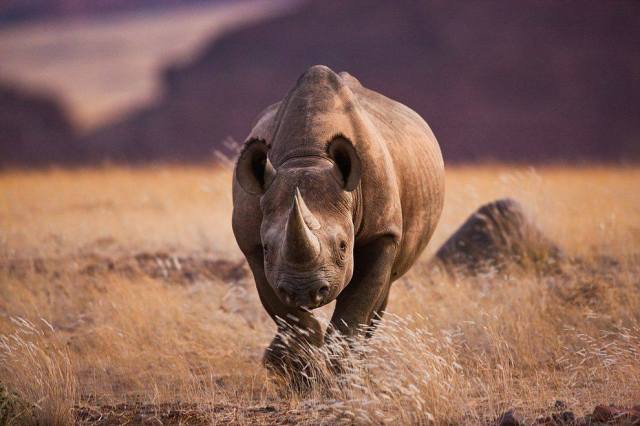It can be. It could be. But recent approaches to the problem are, to my mind, verging on the bizarre.
Rhino are being wiped out at an alarming rate, something all of us are totally aware of and are continually looking for ways to combat the slaughter.
A frighteningly large number of hi-tech ‘solutions’ are being presented all over the place, all available for massive amounts of cold hard cash, but they are not solutions, they are simply a way to make money at the expense of our wildlife.
For instance:
Fairly recently, and with great fanfare, pride and world-wide publicity, a small camera system was developed to insert into a rhino’s horn. The publicity machine went so far as to state that this will “save the rhino from extinction”. Oh yeah? How the hell will it do that?
The camera would be triggered only if some drastic event, like the rhino being shot, occurred.
Well whoopee-doo! The poachers now not only have a rhino horn, they also have a nifty little camera for no extra effort. Oh, I know the images were transmitted to some base-station, somewhere, so that the operator now has some really cool pictures of a poacher in action.
But it’s too late, people! A rhino is dead.
And with so much publicity about the technology, the poachers will, from now on, ensure that their faces are covered rendering them unidentifiable.
Who benefits?
Not the rhino, that’s for sure.
Another one:
Collars or ankle bracelets containing tracking devices and a multitude of sensors, monitor the animal’s whereabouts and well-being, sending all the info back to a base-station. A wealth of data is collected, not least of which is the magical ability to inform the operators if the animal has fallen over and is not breathing.
Again – too late, people, the rhino is dead, another horn gone. But at least they know where the body is.
Poisoning the horns. Oh give me a break! That only has an effect on the end-user who will get sick. But in order to make some fat-cat ill, a rhino has to die. An unfair trade, I would say.
Occasionally though, a superb idea is born and implemented. A really clever, sophisticated marriage of drone, satellite imagery, video systems and a massive amount of complex mathematics developed by a group of really clever people. A system that, in field trials, was proved to work. Unquestionably. Efficiently. Sensibly.
What is it and why haven’t we heard about it?
We have, but only briefly, very briefly.
The system is a collaboration between the technology and rapid-response ranger teams.
The technology is hi-tech in the extreme, but is ‘intelligent’ enough to be able to determine, with 90% certainty where poachers are likely to be.
It’s a paradigm-shift: don’t look for the poachers. Find the rhinos and calculate the probabilities of those animals being targeted.
There are a number of factors built into the algorithms: almost all poaching incidents take place fairly close to boundary fences, usually within 160 metres of a road, and during nights when there is good moon-light.
Once animals have been found by the drone, the mathematics kick in and crunch the data, alerting the ranger team if a threat is determined to be a possibility.
On the first test flight, the UAV found a female rhino and calf in a vulnerable position. They were within 30 metres of a road and within 500 metres of the fence-line. The drone calculated the risk factor, alerted the response team and began circling the area, sending real-time video back to the ground-station.
Shortly after the rangers were in position, the drone showed a vehicle stopping by the fence. Three men exited the vehicle and began to climb the fence. Three minutes later all three were arrested by the rangers. Three minutes!
This success has been repeated over and over again during a 20 month test phase.
Interestingly, in areas where the system was deployed, a number of poachers were stopped before they could carry out their missions, but as the word travelled, poaching stopped completely in these areas within five to seven days of system deployment.
So here is the proof of concept and proof that it works, and works well, in practice.
Why haven’t we heard more about this?
Why hasn’t it been deployed in all areas where rhino are under threat?
Why?
Because some obscure law was either dragged out, or a new one made, stating that low-flying drones could be a potential risk to other aircraft in the area.
Piss-poor excuse, really, you must agree.
I would suggest that the real reason is that an illicit, illegal, untraceable pile of money is much too attractive to corrupt politicians, corrupt reserve management and corrupt big-wigs with friends in high places to allow this to happen.
The flashy life-style, the fancy cars, the large mansions and off-shore bank accounts would no longer be available, and of course, the deep-seated desire not to be caught, means that a workable solution will be discarded and the carnage will continue.




The solution to the problem we are having is calling upon all united Nations to come up in an Agreement of ending all the Markets of Wild Animals , we must end the Demand for the supply will be of no need. Again a lot of conservations Education is crucial in communities and empowering the people on the ground with material support.